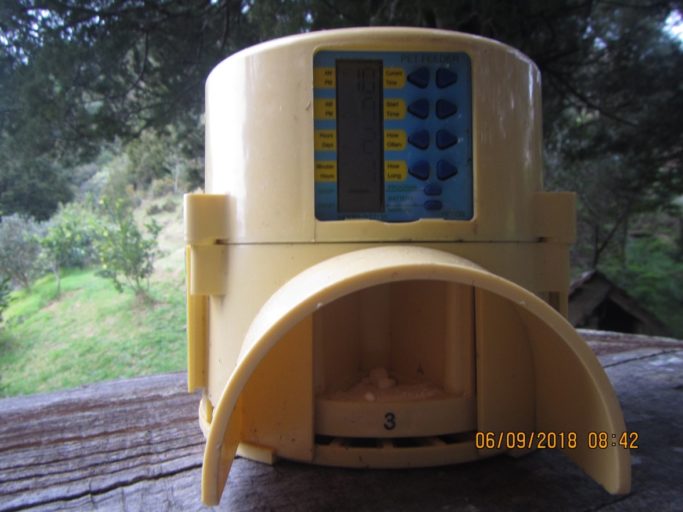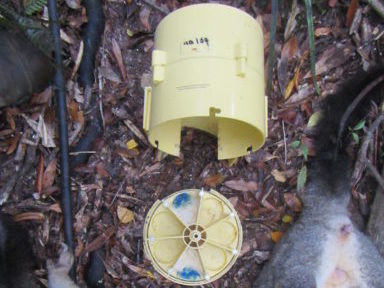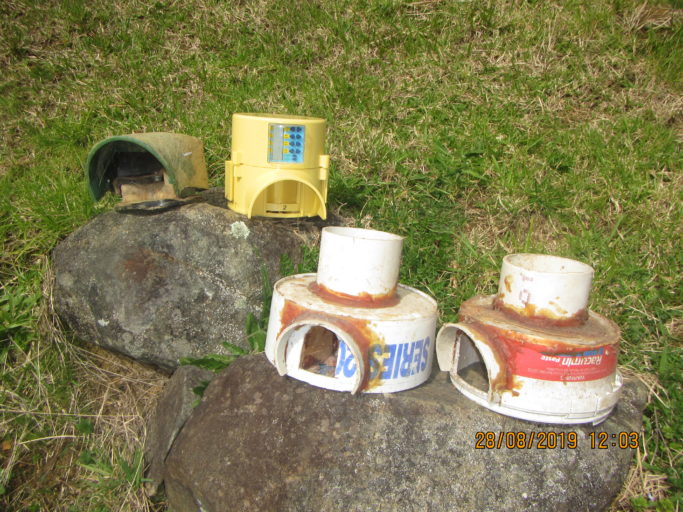Shane Hyde of Kaeo (Whangarei) left school at 16 and spent years working on predator control and weed control projects, but ill health in 2006, after spraying herbicides, forced him to rethink how he approached the physically demanding outdoor work.

The next few years weren’t easy – but ultimately those challenges inspired Shane’s development of the EnviroMate100™ (EM100) smart automated bait station with excluders.
So what is EnviroMate100?
“The EM100 bait stations are time-controlled dinner dishes, holding just enough to tease,” Shane explains. “You decide what is for dinner and when it is to be served. Target species are the same as for aerial delivery pest control operations: possums, rats, mice – plus stoats and cats through secondary poisoning or trapping assistance. An addition is wasp control. But all these are targeted in a controlled, managed way.”

Those dinners, whether pre-feed lures or toxins, can be scheduled from once every 12 hours (daylight/dark), once a day or up to a maximum of once every 7 days, to be visited every 49 days for servicing.
“The delivery of non-toxic lures followed by predetermined toxins is possible within any delivery schedule,” says Shane. “Acute delivery is guaranteed in a controlled manner, reducing both the number of visits to the site that are required and the materials needed to achieve success.”
With small, controlled amounts released, rats, for example can’t hoard. There is less wastage, less spoilage and toxins aren’t left in the environment. The EnviroMate100 can also be used loaded just with lures to enhance trapping success in areas where toxin use isn’t permitted.
“It complements traps with pre-feeding and accumulating pests to the site, increasing the trap capture per visit,” Shane explains.
Trapping then becomes more effective and efficient as predators are drawn to the trapping area with the promise of those regular ‘dinner deliveries’ and, because it’s all automated, the trapper only has to visit occasionally to service the EnviroMate100 and empty traps.
Shane began developing the EnviroMate100 in 2009/10, three years after first becoming ill.
“When I was well enough 2009/10, I entered a DOC contract possum control (2,000ha) as I could manage my daily fatigue being self-employed. But I soon realised performance monitoring had flaws – that for a contractor to be successful, the entire operation zone needed to be worked simultaneously due to reinvasion speed in Northland,” Shane says. “I started to design and build a bait station that was automated in food delivery and toxin in 2009/10 in my workshop at home.”

“Evolution enables individual designs to change and improve,” Shane explains. “My first design came from a plant pot and evolved into a plant pot that hung on a tree with a rain cap and impeller fitted inside; automation being provided by me each day,” he says. “It worked a treat with 4 dead possums underneath on the 7th day, the day of poison delivery.”
He soon hit a point where compromise was needed, however.
“That’s when I found automated cat feeders could be used in the short term to determine if the concept would work,” Shane says. “The cat feeders required modification to be used outside and up trees. The conceptual design elements worked brilliantly, even if not all the cat feeders survived the weather and application!”
The cat feeders enabled learning and development of concept, whilst Shane completed two further contracts. Good luck and the internet helped take the project to the next stage.
“With luck I stumbled through the ‘net’ and landed at the feet of a German engineer who, by luck, owned a company well suited to automation,” Shane explains. “My project was picked up and we carried on to bring working models to life.”
Night vision cameras were used in 2012 to understand the target and its approaches. 2014 saw the first working prototype and commercial production models have been available since 2016.
“Today we have enviroMate100 tested and proven in the field at scale,” Shane says. “Our clients in pest control operations were delighted to have dramatically increased captures and the fur buyer also benefited with possum death becoming predictable to a single day enabling collection.”
Those who’ve tested the enviroMate100 in the field have included Kaeo’s local Mahinepua Landcare Group.
“Our local Landcare Group who have been trailing automated feeders are delighted with the results gained by Martin (their pest control operator),” says Shane. “There was a dramatic initial increase in capture then the decline at each site. It’s amazing how much I gained from their innovative use of the technology,” he adds.
According to Shane, “trapping smart” with EnviroMate100 offers many diversified management options.
“The 9 volt battery in EnviroMate100 that drives the automation saves many trapper trips to site reloading, enables targeting of pest species only in an acute controlled manner saving lots of toxins and materials otherwise wasted, let alone the weight to carry bait to remote corners whilst servicing. Our independent possum control contractor, Jim Lewis, said he could never go back to how he operated before,” Shane says. “Every contract can now be a winner and at least get payment for work completed. The potential pest killing power is huge and can be spread over a longer delivery window to protect threatened species from anticipated seasonal threats.”
Shane describes how he sees EnviroMate100 being used for a large-scale predator control or eradication project.
“EnviroMate100 is moving through the landscape every 28 days, ideally a “stand alone system” (reduction of a projects capital investment) for the concurrent knock down to eradication of multiple species of pests. For eradication low density trapping is also required along with extended EnviroMate100 delivery per site. The management system offers opportunity to operate in any landscape that can be traversed by foot, supported with huts/ camp sites and helicopters where bulk equipment movement is required to remote locations. We have found EnviroMate100 to be an effective boundary control tool dramatically improving efficiencies enabling all weather control and aiding existing control efforts to succeed against re invasion.”
To date, applications for development funding from New Zealand sources have been unsuccessful, but other support, both in New Zealand and overseas, has helped Shane to develop, mass produce and test the product in the field.
“We’ve not received a cent to date from funding avenues, though did lose two months of time and effort trying,” Shane confirms. “But we have been extremely lucky with private support from China with manufacture and commercialisation. New Zealand is very different in business than China. We have a lot to learn about mutual relationships in the development process. We didn’t have the means to enable New Zealand ‘money up front’ to build this technology.”
Other forms of local support were forthcoming, however.
“We’ve had Bernie’s expert assistance since participating at the Mystery Creek Innovation Tent in 2014 and have had the chance of paid work opportunities whilst researching, with both private and DOC contracts,” says Shane. “Our local DOC team have been very enabling to this development,” he adds, “And we are grateful that Jim a recognised independant pest control contractor has stepped up to try and test EnviroMate100 in Ospri TB operations just using trapping. The monitored results are amazing!”
Sustainability is a key motivation for Shane and his family.
“The aim of the EnviroMate100 is to enable single operators to maintain much larger landscapes and manage operations in a planned and controlled manner. EnviroMate100 is designed to move through the landscape providing knock down or to defend the boundary,” Shane says. “Data is collected at service, as presence or absence is broken into the individual days of delivery. No bait take is a great sign especially if it is across 14 days of delivery. It has been very common to have no trap catch but non toxic bait take continues.”
“Sustainable design is what I do,” he explains. “This applies to all we do as a family and our company. Eco-land Ltd is “carbon surplus” and chemical-free where possible. It’s about promoting sustainable design and challenging systems and approaches. It’s this questioning that is more important than individual design – it takes others out of comfort zones.”
Shane admits there have been big challenges over the years as he has independently developed and refined his product.
“This particular independent developer left school at the age of 16,” he says. “My abilities are overlooked when funding applications are reviewed possibly due to presentation. ‘Habit of Mind’ (the tendency to resort to what is known through training), limits easy access to support and markets regardless of the purity of the innovation,” he believes.
“I continue to strive like those in my family before, to build things ‘Kiwi’ from wire – yes number 8 wire. The project so far is ten years,” he adds, “But the knowledge gained to enable it is much longer – a lifetime combined with others’ lifetimes!”
Find out more about the EnviroMate100.

